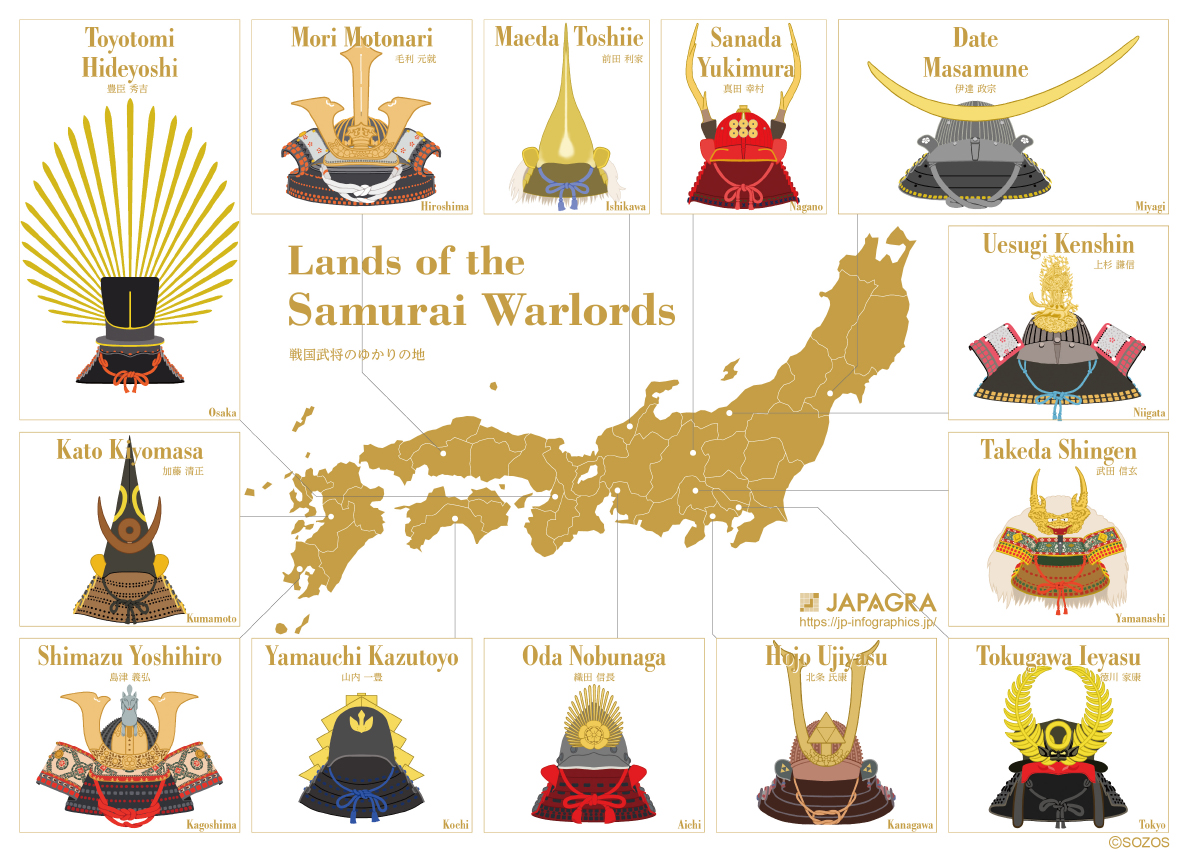Lands of the Samurai Warlords
During the Sengoku period, warlords from across Japan vied for supremacy. Even in life-or-death battles, they adorned themselves with extravagant and unique armor, always expressing their individuality.
In this infographic, we showcase the flamboyant helmets of famous warlords and the places associated with them.
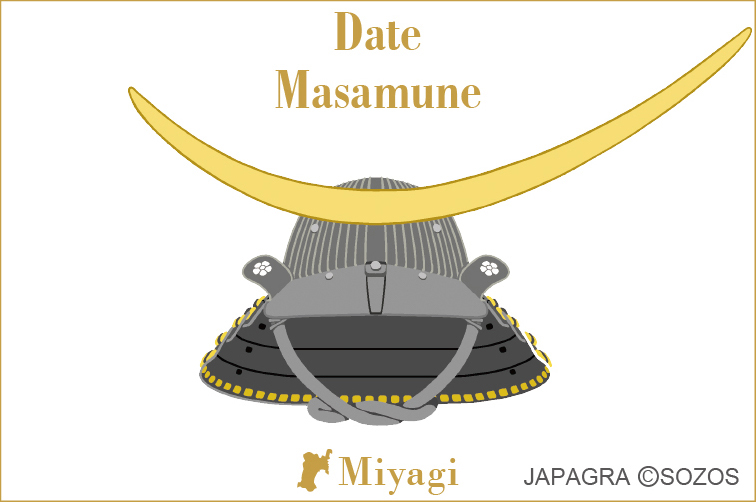
Date Masamune (1567-1636) was the first lord of the Sendai Domain (present-day Miyagi Prefecture). Losing his right eye in childhood, he became known as “Dokuganryū” (the One-Eyed Dragon). A brilliant strategist, he unified the Tohoku region at a young age and contributed significantly to the development of Sendai after Tokugawa Ieyasu unified Japan. Known for his refined taste, his helmet, adorned with a crescent moon crest, reflects his aesthetic sensibility. He was also proactive in cultural and international exchanges, sending a diplomatic mission to Europe, demonstrating his forward-thinking leadership.
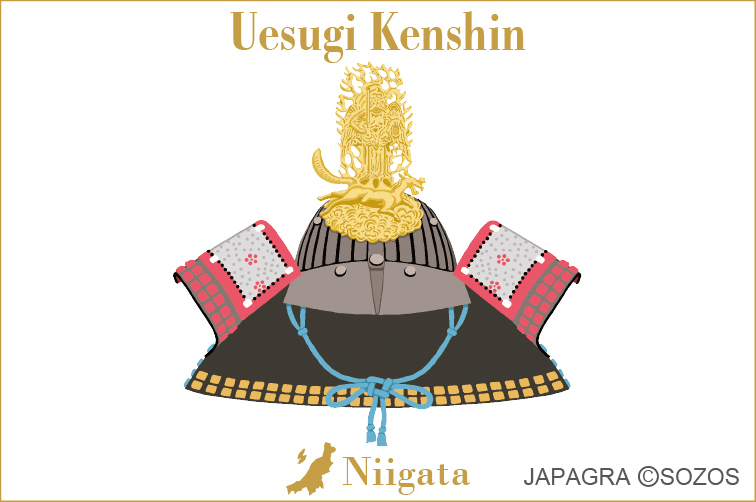
Uesugi Kenshin (1530-1578), a warlord from Echigo (present-day Niigata Prefecture), was renowned for his martial prowess, earning the title of the “God of War.” His fierce battles against Takeda Shingen at the Battle of Kawanakajima are legendary. A devout believer, he considered himself an incarnation of Bishamonten, the god of war. His helmet bore the insignia of “Izuna Gongen,” a deity revered by Sengoku warriors seeking victory in battle. Kenshin’s lifelong commitment to righteousness continues to inspire many.

Sanada Yukimura (1567-1615), born in Shinano (present-day Nagano Prefecture), fought bravely for the Toyotomi clan in the Siege of Osaka. Ueda Castle in Nagano, where he and his father, Masayuki, successfully repelled Tokugawa forces, remains a historic landmark. Yukimura’s striking red armor, known as “Akazonae,” was complemented by a red helmet adorned with the “Six Coins” family crest and deer antler ornaments. His strategic brilliance and fearless last stand earned him the admiration of even his enemies, with Tokugawa Ieyasu calling him “the greatest warrior in Japan.”
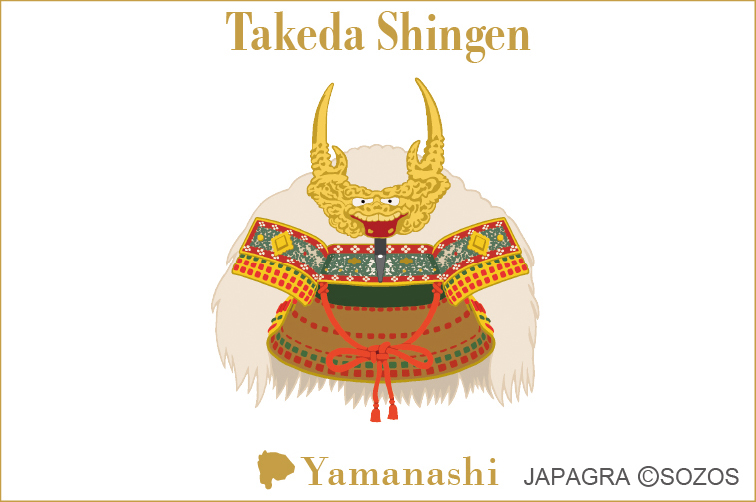
Takeda Shingen (1521-1573), known as the “Tiger of Kai” (present-day Yamanashi Prefecture), commanded a formidable cavalry and built one of the strongest armies of the Sengoku era. His military philosophy was epitomized by the “Fū-Rin-Ka-Zan” banner, derived from the ancient Chinese military text The Art of War. Additionally, the helmet, adorned with a golden-horned lion ornament and white yak hair, features a truly distinctive design.Today, Takeda Shrine in Kofu City attracts numerous visitors seeking blessings for victory.
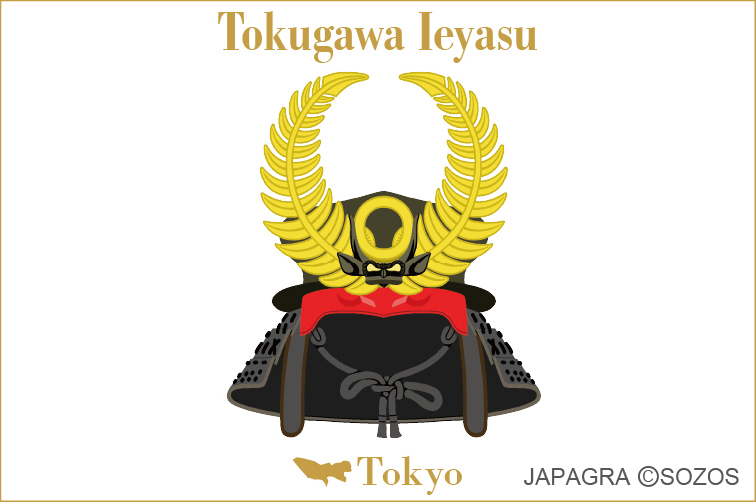
Tokugawa Ieyasu (1543-1616) ended the Sengoku period by defeating the Toyotomi clan and unifying Japan. Establishing the Tokugawa shogunate in Edo (present-day Tokyo), he laid the foundation for 260 years of peace. The helmet used in the Battle of Sekigahara was said to be shaped like the hood of “Daikokuten” and decorated with fern leaves. The city planning initiated by Ieyasu laid the foundation for modern Tokyo.
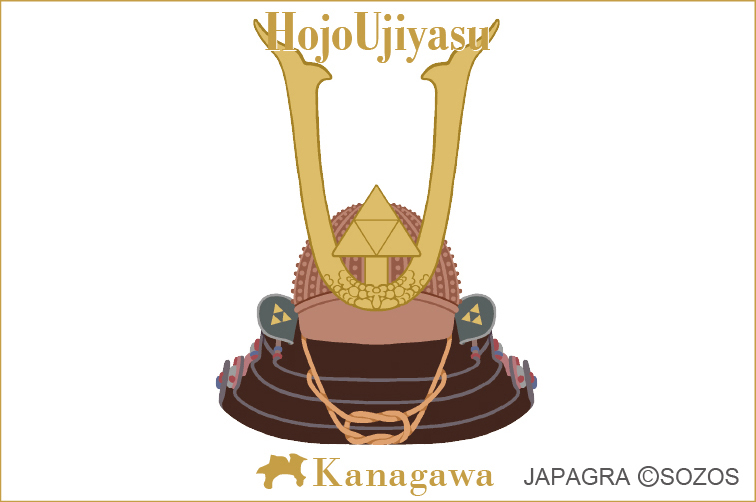
Hojo Ujiyasu (1515-1571), who ruled the Kanto region from the nearly impregnable Odawara Castle (present-day Kanagawa Prefecture), expanded his influence through shrewd governance and military tactics. His helmet bore the Hojo family crest, “Mitsu Uroko” (Three Scales). In addition to his military achievements, he implemented land surveys, tax reforms, currency standardization, and infrastructure improvements, solidifying his reputation as a wise ruler. Today, Odawara Castle remains a popular historical site.
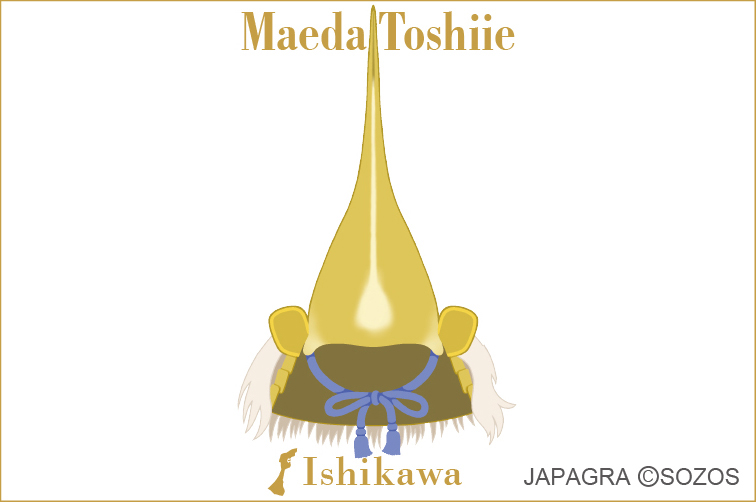
Maeda Toshiie (1538-1599), who established the Kaga Domain with a vast one-million-koku rice production, served Oda Nobunaga and later Toyotomi Hideyoshi. A master of the spear, his helmet was a unique, pointed eboshi-style (court cap-shaped) design made of leather and covered in gold leaf, extending about 70 cm in length. Despite his martial prowess, he was also well-versed in tea culture, contributing to Kaga’s cultural prosperity, a legacy that endures today.
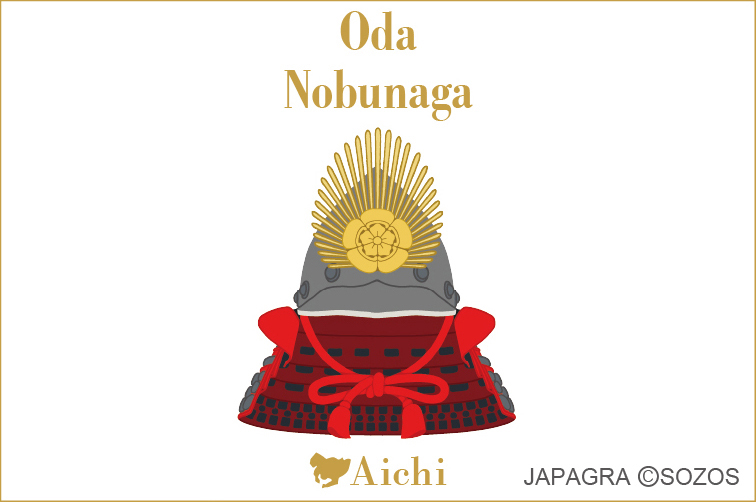
Oda Nobunaga (1534-1582) was on the verge of unifying Japan before being assassinated in the Honno-ji Incident. Initially dismissed as the “Fool of Owari” (present-day Aichi Prefecture), he proved to be a revolutionary leader, pioneering the use of firearms in battle. Numerous historical sites in Aichi, such as Kiyosu Castle and Nagoya Castle, are linked to him. His helmet featured the Oda family crest, “Mokko-mon” (Japanese quince crest). Nobunaga remains one of the most celebrated and influential figures in Sengoku history.
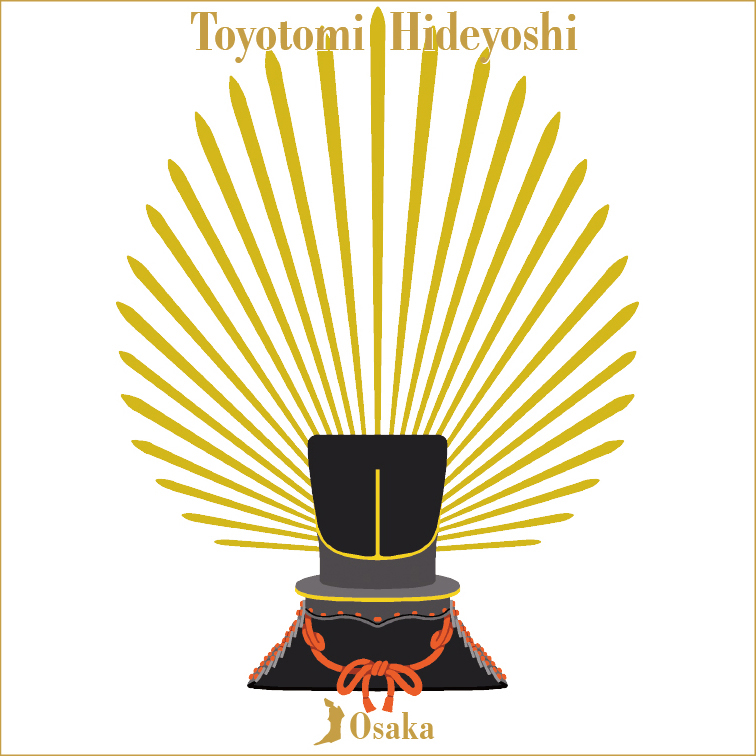
Toyotomi Hideyoshi (1537-1598) rose from a peasant background to become Japan’s ruler. After succeeding Nobunaga, he eliminated rival warlords and unified the nation. Hideyoshi was known for his love of extravagance, and one of his most famous helmets featured multiple leaves of barin (a type of iris), creating a striking design that appeared as if radiating a divine aura. Osaka Castle, his stronghold, was destroyed in the Siege of Osaka but was later rebuilt and remains a symbol of the city.
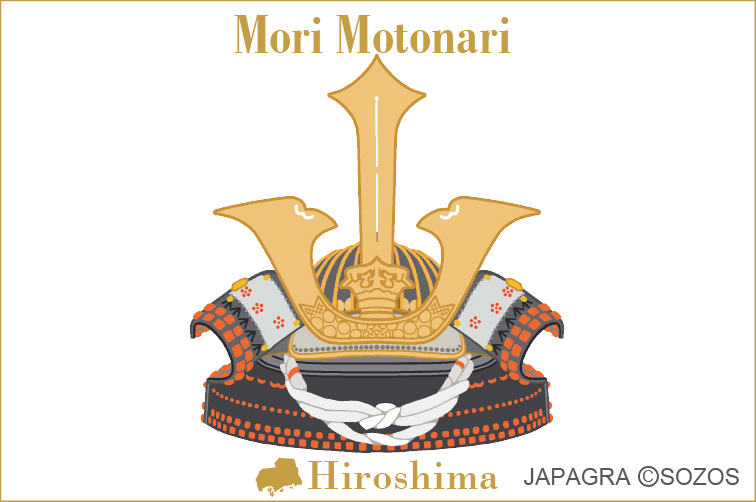
Mori Motonari (1497-1571) was born in Aki Province (present-day Hiroshima) and became the dominant ruler of the Chūgoku region through strategic brilliance. He is famous for the “Three Arrows” lesson, teaching unity to his three sons. His helmet, reflecting Muromachi-era styles, featured three golden crests and intricate designs exuding dignity. Many historical sites in Akitakata City preserve the legacy of the Mori clan.
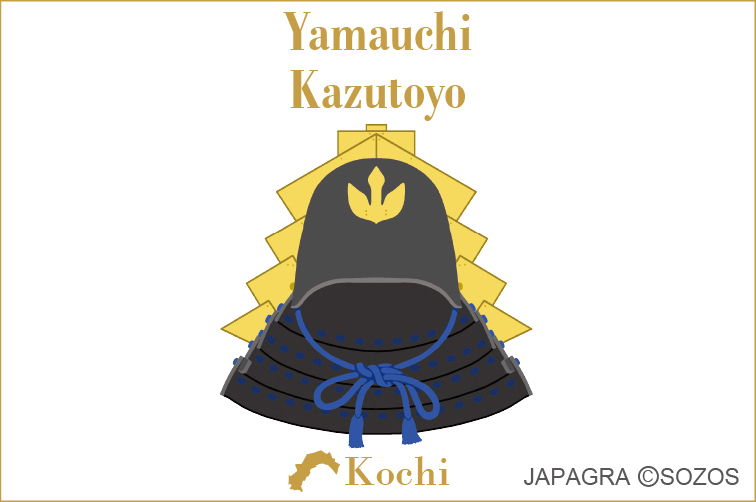
Yamauchi Kazutoyo (1545-1605) became the first lord of the Tosa Domain (present-day Kochi Prefecture). He is renowned for his wife’s support, which greatly contributed to his rise in status. His helmet was coated in black lacquer and decorated with a gold-leafed “Gohei” (Shinto offering). The Kochi Castle, built by Kazutoyo, is one of the twelve castles in Japan with a main keep that has survived since before the Edo period. It is the only castle in Japan where both the main keep and the honmaru palace remain, preserving a valuable glimpse of history.
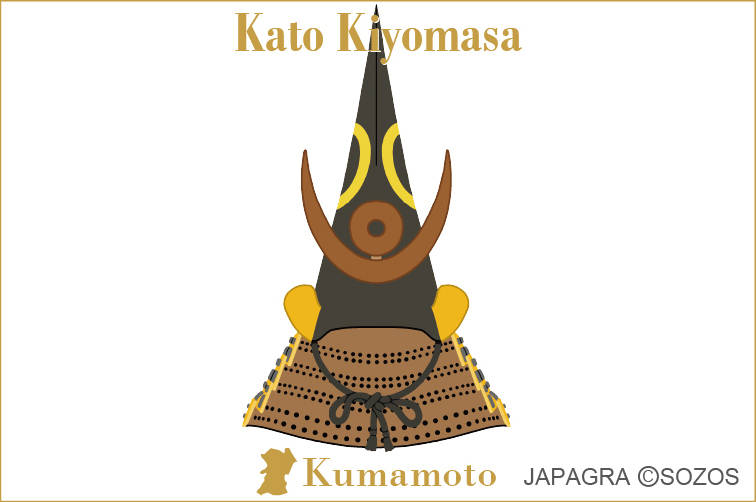
Kato Kiyomasa (1562-1611), the first lord of the Kumamoto Domain (present-day Kumamoto Prefecture), was a master castle builder. His most famous creation, Kumamoto Castle, is recognized as one of Japan’s three great castles. Kiyomasa’s trademark was his long eboshi-shaped helmet, which featured the “Janome-mon” (Snake’s Eye Crest), a symbol of his family emblem and a protective charm against evil. He also contributed to flood control efforts, earning lasting respect in Kumamoto.
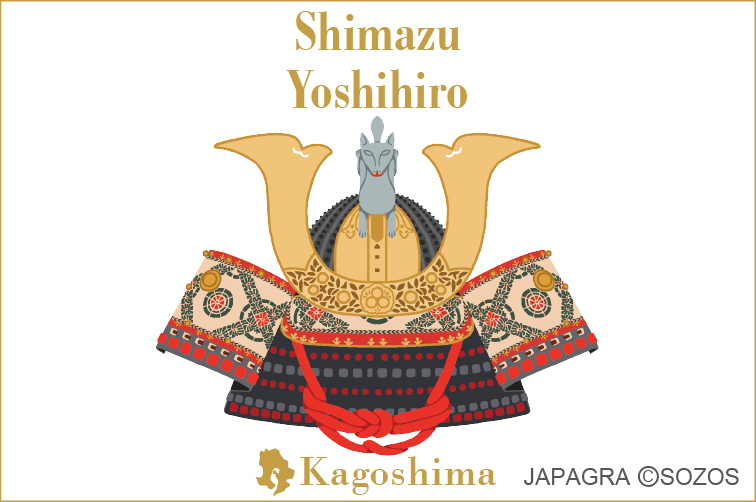
Shimazu Yoshihiro (1535-1619), a descendant of the ruling Shimazu clan of Satsuma (present-day Kagoshima Prefecture), was the younger brother of the 16th clan head, Shimazu Yoshihisa. He played a crucial role in expanding the Shimazu family’s influence. Known for his exceptional battlefield prowess, he earned the fearsome nickname “Oni Shimazu” (Demon Shimazu). His helmet was adorned with a fox ornament, symbolizing the guardian deity of the Shimazu family. Sengan-en, the Shimazu family’s villa, remains a key historical site in Kagoshima.
Sources
“Sengoku History: Interesting because it’s about warlords by region” Tetsuo Owada (reader), Asahi Shimbun Publications
Articles










